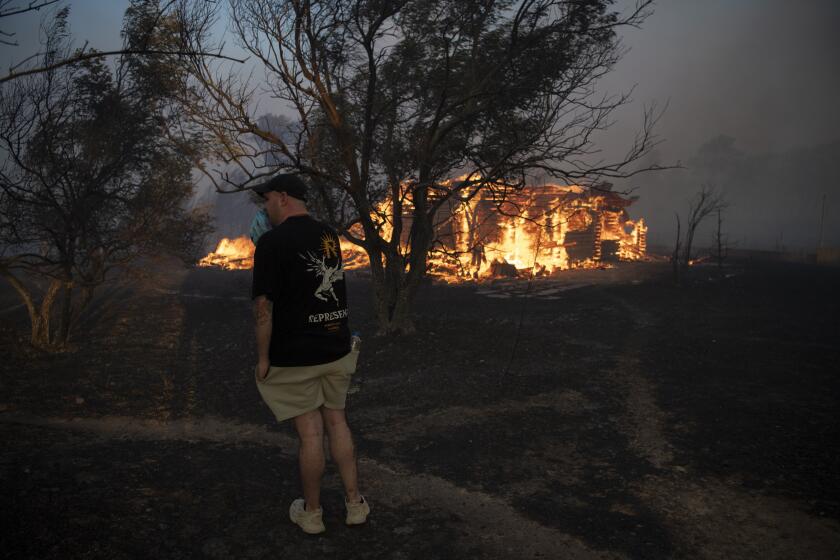Opinion: Wildfire smoke is polluting California. Here’s how to protect yourself

- Share via
The Santa Ana winds caused a massive wildfire this month in Ventura County, with stunning visuals of orange skies in Oxnard reminiscent of 2020 in the San Francisco Bay Area. Although the Mountain fire is now just about contained (as is the Sandy fire in Monterey County), it was the most destructive fire to hit Southern California in six years, polluting air past Ventura toward Santa Barbara and beyond. With the Santa Ana winds and an ever-lengthening fire season, smoke could spread again through November and into December in Southern and Northern California, as happened in 2017 and 2018.
And it’s not just a West Coast problem: The Northeast is facing its worst fire season in more than a decade, prompting evacuations in New York over the weekend.
In affected areas, residents urgently need to protect themselves from inhaling wildfire smoke, which is comparable in composition to secondhand smoke without the nicotine. Hazardous smoke particles can cause or exacerbate heart and lung diseases miles away.
A new study in Science found that California wildfires are growing four times as quickly as they did 20 years ago. Experts say that the danger increases with faster growth.
The South Coast Air Quality Management District recommends staying indoors and running air conditioners or air purifiers. This generic advice is helpful but does not go nearly far enough. There are five specific steps that can safely limit your exposure to the extreme levels of toxic particles during these large fires.
First, be informed. Local air quality monitors, the PurpleAir community scientist network and other online services can give a clear picture of particle pollution in your area. Handheld and desktop personal particle monitors are also available for purchase. You can’t rely on the sky’s color, which can be deceiving: In 2020, wildfires turned San Francisco’s sky dark orange, but air quality was actually worse after the sun returned and the skies looked more normal, because by then smoke particles were dropping closer to the ground, into the air people breathe.
Second, stay indoors and keep your windows and doors closed, which can reduce exposure to outdoor pollution by as much as half.
However, particles still seep through cracks, and closing windows and doors also traps exhaled breath, increasing the risk of spreading respiratory illnesses such as COVID-19 or the flu. That leads to the third important step: Clean up the outdoor pollution that enters indoors, as well as potentially hazardous breath particles.
Central ventilation, even if it’s filtered, typically needs to be supplemented with appropriately-sized room air purifiers. In 2023, the Centers for Disease Control and Prevention recommended at least five air changes per hour for occupied spaces indoors, and this month the California Department of Public Health reiterated this recommendation specifically for classrooms.
The suburban sprawl and landscape destruction that helped fuel the fires around Athens apply in Southern California too.
The number of air purifiers needed to meet this target varies based on the dimensions of the room, the model of air purifier and the speed and noise-level that occupants find acceptable for the purifier. High-efficiency particulate air, or HEPA, purifiers running at five to 10 air changes per hour cost $1 to $5 per square foot for typical ceiling heights, and indoor particle exposure can be reduced by 10 to 50 times relative to the outdoors, depending on the rate of particles still seeping into the room once doors and windows are closed.
If getting purifiers for your entire home is daunting, you can focus on making at least one room safe, such as your bedroom. Low-cost (around $20) infrared motion switches hooked up to purifiers can conserve power and prolong filter life by switching air purifiers on when people enter the room and off with a time delay after they leave.
HEPA purifiers often sell out during peak wildfire season. A do-it-yourself purifier can be made in 10 minutes with more consistently available components, a box fan and a MERV 13+ furnace filter sold online, at a cost typically five to 10 times cheaper than HEPA options. Alternatively, even if lower-grade filters are the only ones in stock in stores or online, some filtration is much better than nothing.
Fourth, in addition to indoor safety, if you need to drive during smoky conditions, you can switch your car’s air system to recirculate. As a longer-term fix, in many cars you can also upgrade your cabin air filter to a HEPA model.
Finally, whether you’re outside or indoors without air purifiers, wear an N95, N99 or reusable elastomeric mask such as a P100, all of which are designed to reduce particle exposure from wildfire smoke by at least 20 times as long as they are fresh and fit well. If these are difficult to wear, especially when it is hot, ventilated industrial helmets with battery-powered fans and filters can be used more comfortably (although they tend to be pricey, starting at around $450).
As climate change intensifies, wildfires are likely to become more frequent and severe. Taking these precautions for wildfire smoke also protects against airborne threats such as respiratory diseases and pollution in general. Don’t wait until the sky turns orange to take action.
Devabhaktuni Srikrishna is an electrical engineer, founder of the air quality website www.patientknowhow.com and vice chair of control and mitigation for the American Assn. of Aerosol Research annual conference.
More to Read
A cure for the common opinion
Get thought-provoking perspectives with our weekly newsletter.
You may occasionally receive promotional content from the Los Angeles Times.












